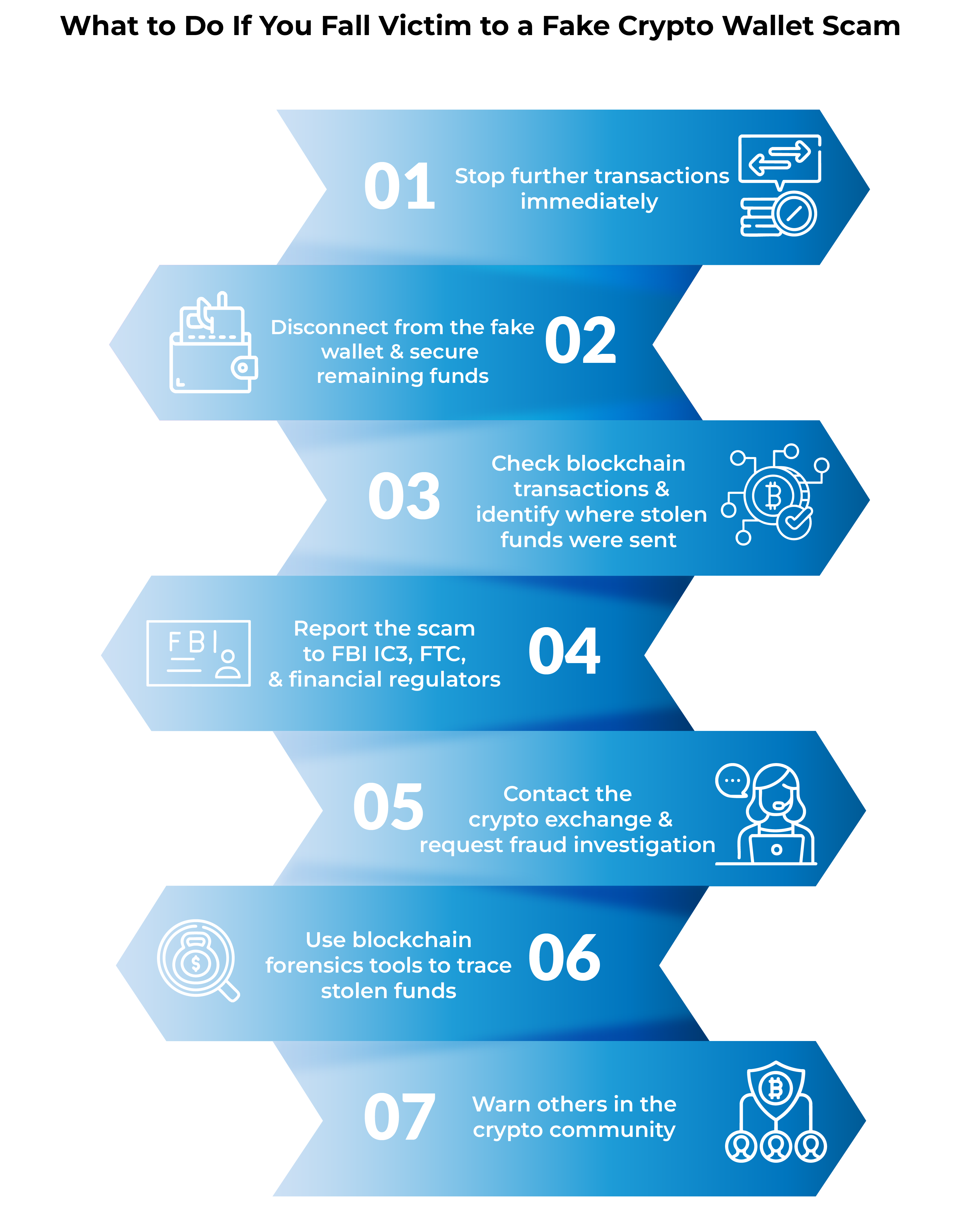
- Cryptocurrency
- March 25, 2025
Table of Contents
In recent years, the crypto market has been exploding, and even those who had no prior knowledge about it are now showing a keen interest. The fact that the crypto market has shown a huge potential to make substantial amounts of money has garnered a lot of attention from even those who first thought that the crypto market was just hype.
However, those who invest in the crypto market do not have enough knowledge and end up losing their money to cyber threats. As per Chainanalysis, about $2.2 billion worth of cryptos was lost to online crypto scams, and it is 89% higher than the previous year.
Moreover, cryptocurrency wallets are garnering a lot of attention in recent times as the number of fake crypto brokers and exchanges is increasing at a high rate.
Losing your crypto to an online fraud can be mentally and financially devastating. Also, it would be too late to blame for the loss, which could have been easily avoided if the proper precautions available had been taken.
Thus, for this reason, securing these cryptos is important, and this article will stress why it is. It is for you regardless if you already have experience in the crypto market or are a newbie. We will take a deep dive to understand the importance and differentiate between genuine crypto wallets and fake crypto wallets.
Understanding Fake Crypto Wallet Scams
A fake crypto wallet is a fraudulent application, device, or online service created to steal funds from users. Scammers use different techniques to trick victims into giving up control over their digital assets, including:
- Fake Wallet Apps: Malicious apps designed to look like real wallets, prompting users to deposit funds
- Phishing Websites: Fake sites that mimic legitimate wallets, stealing login credentials
- Trojanized Wallets: Wallets that contain hidden malware, allowing remote access to funds
- Fake Customer Support Scams: Impersonating official wallet providers to manipulate users into revealing sensitive data
Many scams rely on social engineering, where fraudsters gain victims’ trust through fake social media profiles, deepfake influencer videos, or Telegram groups promoting fraudulent wallet services.
How Fake Crypto Wallet Scams Work?

Scammers use various tactics to deceive crypto users. Some of the most common methods include fraudulent wallet apps that appear on app stores with fake positive reviews, phishing attacks where scammers send emails or messages with fake login pages tricking users into entering their credentials, and fake customer support where fraudsters pose as official representatives convincing victims to share private keys.
Some fake wallets contain malware that allows scammers to access victims' funds remotely. Social media and online ads are also used to promote fraudulent wallets, leading unsuspecting users to download and use them. Once scammers gain access to a victim’s wallet, funds are immediately transferred to scam-controlled addresses, making recovery nearly impossible.
Where Fake Crypto Wallets Are Distributed?
These fraudulent wallets are aggressively promoted across various online platforms. Fake apps disguised as real wallets appear on Google Play & Apple App Store, phishing websites mimic legitimate wallets, and fraudulent promotions on Facebook, Instagram, and YouTube lure victims.
Scammers use Telegram and Discord groups to promote scam "airdrop wallets" that ask for deposits, while fake search engine results lead to phishing links. Deepfake influencer scams also play a role in tricking users into downloading fake wallets.
Red Flags: How to Identify a Fake Crypto Wallet
Fake wallets can be hard to detect, but some warning signs indicate a potential scam. If a wallet has no official website or verified developer information, requests private keys or seed phrases during setup, asks for excessive permissions like access to contacts or cameras, or has suspiciously high ratings with fake positive reviews, it is likely fraudulent.
A legitimate wallet provider will never ask for private keys, and any service requesting them should be treated as a scam.
Table: Fake vs. Legitimate Crypto Wallets
|
Feature |
Fake Crypto Wallet |
Legitimate Crypto Wallet |
|
Source of Download |
Hosted on phishing websites, fake app stores, or unknown third-party links. |
Available only on official wallet websites, Apple App Store, or Google Play Store. |
|
Security & Verification |
No official security audits or open-source verification. |
Transparent code, open-source, and verified security audits from third-party experts. |
|
Permissions Requested |
Requests unnecessary access, such as contacts, microphone, or camera. |
Requests only relevant permissions needed for crypto transactions. |
|
Customer Support |
No legitimate support or redirects users to phishing sites. |
Has official customer support channels with verified contact details. |
|
Private Key or Seed Phrase Request |
Asks for seed phrases or private keys during setup. |
Never asks for private keys or seed phrases. |
|
Reviews & Reputation
|
Fake or minimal user reviews, often inflated ratings. |
Has a long-standing reputation with real user feedback on forums like Reddit and BitcoinTalk. |
Real-World Case of Fake Crypto Wallet Scams
Scammers created a fake trust wallet app on Google Play; this app was so deviously created that it resembled the original Trust Wallet. This fake crypto wallet also had fake reviews of the app, which further enticed crypto users to download this app.
After downloading this fake app, the app prompted its users to provide their private key details under the fake assurance to recover their cryptos in case of restoring the wallet. These details were sent directly to the scammers.
For a while, this wallet allowed its victims to carry out transactions, but later, it started sending their cryptos directly to the scammer's wallet.
Why Fake Crypto Wallet Scam is Popular?
The Google Play Store hosted both the original Trust Wallet and a fake one. Due to the deceptive tactics of scammers, including fake reviews of the site, which further boosted its popularity and rank ahead of the original one.
The other reason for the popularity of this fake crypto wallet was through social engineering. It was promoted on email and social media platforms.
How to Avoid Fake Crypto Wallet Scams?
Let’s discuss the tips to avoid fake crypto wallet scams.
1. Download Wallets Only from Official Sources
- Always visit the official website of a crypto wallet provider to find download links.
- Cross-check app reviews, ratings, and developer information before installation.
2. Enable Two-Factor Authentication (2FA)
- Activate 2FA on wallets and exchange accounts for an added layer of security.
- Avoid using SMS-based 2FA, as SIM swapping attacks can bypass it.
3. Never Share Private Keys or Seed Phrases
- Store private keys offline in a secure location, such as a hardware wallet or written note.
- If a wallet provider asks for your seed phrase, it's a scam—report it immediately.
4. Use a Hardware Wallet for Large Crypto Holdings
- Hardware wallets like Ledger and Trezor provide better security by keeping private keys offline.
- Always purchase hardware wallets directly from the manufacturer's website.
5. Beware of Crypto Giveaway Scams
- If it sounds too good to be true, it probably is.
- Avoid offers that promise free cryptocurrency in exchange for deposits or personal information.
6. Regularly Update Wallet Software
- Keep wallet apps updated to ensure security patches are applied.
- Avoid using outdated software versions that may have vulnerabilities.
By recognizing red flags and following security best practices, users can significantly reduce the risk of falling victim to fake crypto wallet scams. Staying vigilant and skeptical of unsolicited crypto offers is key to safeguarding digital assets in the ever-evolving crypto landscape.
Also, check out our detailed guide on How to Choose the Right Crypto Wallet.
What to Do If You Fall Victim to a Fake Wallet Scam?

If you suspect that your funds have been stolen, immediate action is critical. Report the scam to FBI IC3, the Federal Trade Commission (FTC), or local financial authorities. Contact your crypto exchange to see if transactions can be frozen. Use blockchain tracking tools to analyze transactions and trace lost funds. Seek professional recovery assistance if a significant amount has been stolen.
While crypto transactions are often irreversible, early intervention can help prevent further losses.
Key Takeaways
- Importance of choosing a genuine cryptocurrency wallet
- How scammers entice their potential victims into selecting their fake wallet
- Working of Bitcoin or cryptocurrency wallet scams
- How to avoid falling for this scam
- In case of falling victim to this scam, what are the recovery steps
FAQs (Frequently Asked Questions)
These create a fraud or phishing application or website that traps a user to provide log-in details and use them to empty funds from the user's account.
Search the official website, developer performance, and reviews from reputable sources. It is forbidden to download wallets from unverified sources.
Recovery is difficult, but reporting the scam to authorities, notifying the cryptocurrency exchange, and using blockchain forensics increase the chance of retrieval.
Yes, they are. Hardware wallets store private keys offline, providing additional protection from hacking and fraud over the internet.
